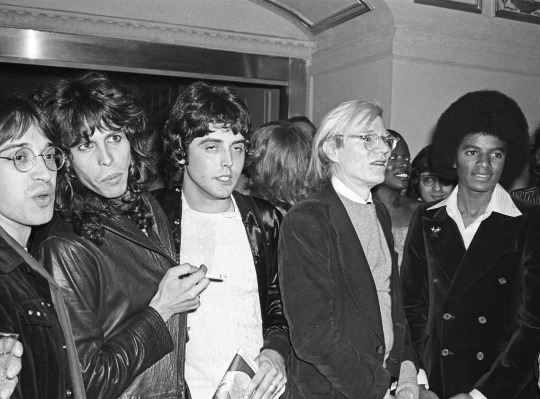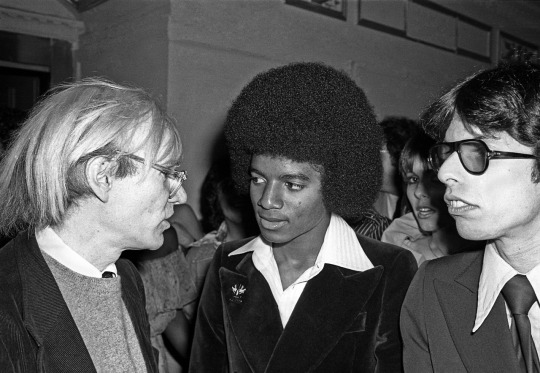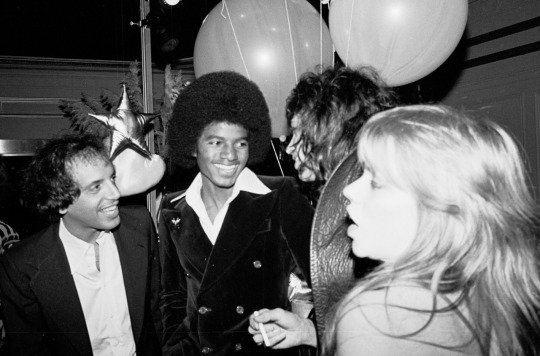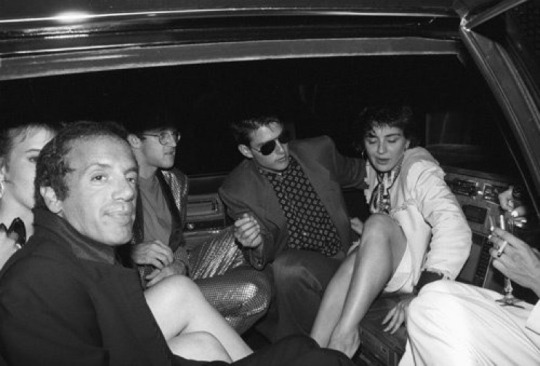#steve rubell
Explore tagged Tumblr posts
Text




Michael Jackson with Mitch Weissman, Steven Tyler, Andy Warhol, Steve Rubell, and Dory Hamilton at the Beatlemania party at Studio 54 on June 9, 1977.
#michael jackson#mitch weissman#1977#ady warhol#steven tyler#steve rubell#dory hamilton#studdio 54#nyc#beatlemania#king of pop#aerosmith
177 notes
·
View notes
Text


Happy Pride to these pictures of Steve Rubell, Andy Warhol, Keith Haring, Tom Cruise, Maripol, and Martin Burgoyne in a limo at Madonna and Sean Penn’s wedding in 1985
#I have consulted the collective and many experts and they all agree that Cruise and Haring are probably doing poppers#steve rubell#andy warhol#keith haring#mairpol#tom cruise#Martin Burgoyne#Madonna#sean Penn
352 notes
·
View notes
Text
Dracula tries to enter Studio 54 with Steve Rubell himself at the door (from 1979 short "Dracula Bites The Big Apple")
7 notes
·
View notes
Text


"Roy Cohn and his good buddy Steve Rubell"
1 note
·
View note
Text
the gay NYC art scene that mj was in and out of
#i just found out steve rubell was gay ('famously' according to andy warhol)#it's just amusing to me the crowd he was running with#rest assured studio 54 was a gay club#i'm just like. i just wonder how much michael realized that#not to say there were no straight people around but like. every new name that pops up....gay. it makes me laugh#also also. i feel like this could come off as some 'guilty by association' kind of talk and that's not what i'm trying to say. to be clear
2 notes
·
View notes
Text
Supergirl #1 (2016) Brian Ching Cover, Brian Ching Pencils, Steve Orlando Story, 1st Appearances of Benjamin Rubel, Mastrocola from Earth-0.
#Supergirl #1 (2016) #BrianChing Cover & Pencils, #SteveOrlando Story, 1st Appearances of #BenjaminRubel, #Mastrocola from Earth-0. "Reign of the Cyborg Superman", part one Supergirl is back and working for the DEO to defend National City! As #KaraDanvers, average American teenager and high school student, Supergirl must balance her life as a superhero with her new life on Earth. SAVE ON SHIPPING COST - NOW AVAILABLE FOR LOCAL PICK UP IN DELTONA, FLORIDA https://www.rarecomicbooks.fashionablewebs.com/Supergirl%202016.html#1 #VertigoComics #Vertigo #KeyComicBooks #DCComics #DCU #DCUniverse #KeyIssue #NerdyGifts

#Supergirl#1 (2016) Brian Ching Cover#Brian Ching Pencils#Steve Orlando Story#1st Appearances of Benjamin Rubel#Mastrocola from Earth-0.#rare comic books#key comic books#key comics#dc comics#dc universe
0 notes
Text

Diana Ross, accroupie dans la cabine du disc-jockey du Studio 54, divertit les joyeux lurons lors de la fête d'adieu organisée pour les copropriétaires Steve Rubell (en bas à droite, en pull) et son partenaire, Ian Schrager (non représenté sur la photo).
36 notes
·
View notes
Text
escolha uma pilha: como seu futuro parceir* agiria quando estiver apaixonado? 🤍
notas: minhas leituras são para todos e atemporais, ou seja, não importa o momento em que chegue até você, pode se indentificar. beijinhos 💋 as músicas listadas abaixo de sua pilha podem ser um recado extra!





Pilha 1 ❀˖°
Primeiramente, sinto que ele acabará deixando evidente que está interessado em você, como se seus desejos se manifestassem sem que ele perceba. Acredito que a última coisa que ele quer é esconder isso de você. Consigo vê-lo se sentindo meio tolo, como uma criança apaixonada que faz de tudo para chamar sua atenção. Há algo relacionado ao passado dele que ele preferiu não comentar, mas parece que isso o motiva ainda mais a querer que as coisas entre vocês funcionem. Pode esperar muita troca de olhares, flertes e conversas vindos dele. Com certeza, ele será bastante persistente.
• sinais: rock clássico, badboy de romcom, 90s, sorriso bonito, extrovertido, aparências. números: 7, 4 e 12.
Pilha 2 ❀˖°
Inicialmente, essa pessoa demonstra um grande autocontrole e tentará negar o que está sentindo, confusa e sem querer enfrentar essas emoções. No entanto, com o tempo, perceberá que está buscando sua atenção e carinho. Ela te enxerga como alguém especial, com quem deseja compartilhar todos os momentos da vida. Pequenos gestos começarão a revelar o quanto ela se importa. Além disso, essa pessoa sentirá uma mistura de ciúmes e raiva diante de terceiros que possam ameaçar o relacionamento de vocês, especialmente ao ver outras pessoas te elogiando ou demonstrando interesse em você.
• sinais: ouvinte x falante, aparência angelical, frio e distante com estranhos, parques, momentos calmos e gentlemen. números: 3, 4 e 5.
Pilha 3 ❀˖°
Essa pessoa tem vontade de agir, mas se sentirá presa ao passado ou a alguém, o que pode ser tanto positivo quanto negativo para você. Caso estivesse em um relacionamento, é provável que considerasse rompê-lo apenas para estar ao seu lado. Parece que seu ambiente familiar foi marcado por situações complicadas, com conflitos e confusões que influenciaram sua forma de se relacionar. Ainda assim, acredito que essa pessoa estará disposta a mudar e ajustar suas atitudes, pois enxerga um futuro ao seu lado, mesmo que o contexto ao redor seja turbulento. No entanto, vejo muitas possibilidades de mal-entendidos, e, sem uma comunicação clara, isso pode levar a desentendimentos e até a um afastamento.
• sinais: gatos, hip-hop, trabalho, café, acessórios e estilo autênticos, frienemies (amigos + inimigos), ex (??). números: 6, 7, 9.

#tarô#tarot reading#future spouse#pick a pile#alternative#kawaii#coquette#ocultismo#tarot community#tarotblr
8 notes
·
View notes
Text

Andy Warhol, Bianca Jagger and Steve Rubell attend a Halston fashion show circa 1978 in New York City.
12 notes
·
View notes
Text




Grace Jones, Andy Warhol, Allan Carr, Olivia Newton-John, and Steve Rubell at the premiere party for "Grease" at Studio 54 in New York City on June 13, 1978.
#grace jones#andy warhol#olivia newton john#allan carr#steve rubell#studio 54#1978#nyc#new york#1970s
194 notes
·
View notes
Text

not NOW iphotos i don’t have time to think about the slurmobile at madonna’s wedding!!!
39 notes
·
View notes
Text
this might be minor spoilers but i truly don't care because i want to talk about bradley and sophia harrington, steve's parents from only i must wander.
bradley is interesting to me because so much of his bad behavior is because while otis was an amazing grimm and person, he was a pretty bad father. he came back from ww2 to a wife he didn't love and a child he barely knew that he missed the first four years of his life. he was distant, and would disappear for weeks at a time. it wasn't until brad was old enough to start training as a grimm that otis took interest in brad, and they began going on short trips together. these trips did very little to improve their relationship, as being introduced to otis's wesen friends and witnessing how much their father cared about these people in contrast to him and his mother only made brad resent his father and the wesens. it wasn't until steve was born that otis's paternal instincts kicked in, and steve and otis's bond only pushed brad further away. having his absent father and his son be so close only made bradley feel further abandoned.
sophia rubel never wanted a family. she definitely never wanted children. with the grimm population dwindling, however, grimm women were under extreme pressure to keep their family lines going. meeting bradley harrington, a non-traditional grimm who did not make the mistake of thinking of wesen as their equals, seemed like a blessing. he did not demand affection or loyalty or even maternal duties from her, only a partner in hunting and a womb. it was enough to get her very traditional family off her back, and that was more than enough for her to accept his proposal. when steve was born, sophia was more than glad to leave everything up to brad and his family. she was more than aware of brad and steve's relationship souring super young, and while she knew it couldn't be good for the kid, she also didn't really know how to step in. it wasn't like she loved steve or wanted to protect him, it was just annoying to see him act out so much as a result of his father's abuse. she's the one who suggested they do more hunts outside of their jurisdictions, in an effort to separate brad and steve. when otis died, she figured that steve was old enough to stay home alone.
#shut up az#oimw#they are so fucked up i'm rotating them in my mind always#like grimm society has Failed these two in ways untold#the generational trauma of otis -> bradley -> steve is Everything#brad could have handled it better. ur dad being gay isn't a good reason to tell you son you'll kill him if he embarasses you.#sophia im obsessed w though like yeah if my society forced me to have a baby i would also be like get this thing away from me#bradley and sophia are jsut evil stobin. btw.
2 notes
·
View notes
Text

Undated, left to right: Roy Cohn, Donald Trump, Steve Rubell, Ivana Trump
2 notes
·
View notes
Text



She became friends with the Hedda Hopper and Louella Parsons of the downtown scene, Stephen Saban of Details magazine and Michael Musto of The Village Voice. Somewhere along the line, she dropped her last name in favor of just the initial. And, one night in a cab, James changed his last name to St. James. Lisa E. and James St. James just seemed to have a nicer ring than Lisa Edelstein and James Clark.
She got a job as a bartender at the Palladium and that cemented her club fame. ''I knew right from the start that Lisa was going to be more than a bartender,'' recalls Steve Rubell, one of the club's owners. ''Just the way I knew that Madonna was right when she used to sit on the steps of Danceteria and tell me she was going to be a star.''
Lisa no longer works at the Palladium, but she is a frequent visitor. ''If there's an opening of an envelope, Lisa's there,'' Rubell says. This very evening, in fact, she is giving a 20th-birthday party for James at the Palladium. ''Thank Heavens for Little Girls!'' reads the invitation, featuring a picture of James wearing lipstick, pigtails and a short plaid party dress and holding a teddy bear, a downtown version of Sebastian Flyte.
Lisa in Wonderland (1986)
26 notes
·
View notes
Text

The Club
“Good Times” (1979) Chic Atlantic Records (Written by Bernard Edwards and Nile Rodgers) Highest U.S. Billboard Chart Position – No. 1
“The key of the success of Studio 54 is that it's a dictatorship at the door and a democracy on the dance floor.” - Andy Warhol
On April 26th, 1977, more than 4000 people showed up on 54th street between 7th and 8th Avenues in NYC to attend the opening of a newly revamped theater turned discotheque (once an opera house in the 1920s) for the grand opening of Studio 54. Eight thousand invites had been sent from many of the bests lists in the city; the line snaked around the block that night with people clamoring to get in. Many celebrities, officially invited, were unable to get through the soon-to-be famous doors. Disco, a popular fusion of soul and dance music, was on the ascendant: hedonistic, generic, joyful, color-blind, and sexually promiscuous (many of the song themes would be about copulation). It was in that year that two newly successful bandmembers from Chic named Bernard Edwards and Nile Rodgers were invited by Grace Jones and unceremoniously turned away at the door. Jones was famously unreliable; there is no telling where she was, but when they didn’t get in they went home and wrote an angry song called “Fuck You”, then changed it to “Freak Out”, then to “Le Freak”, which then went on to become one of the biggest disco songs ever written, and afterward they went to Studio 54 as often as they liked, because there is no golden ticket in the world like fame.

I am sure I don’t have to tell you what Studio 54 was: it was one of the most glamourous, glitziest, expensive spaces in New York. It was a party where everyone, anyone, had a good chance to get in. It held 2,500 and often had more; it had back rooms, was famous for the famous, and sex, and drugs. It had an incredible light show and sound system, and the best DJs. But most of all it was entirely and profoundly mixed: rich, working class, old, young, black, white, gay, straight, gender fluid, normcore. The two owners, Steve Rubell and Ian Schrager, had two rules: they wanted it full, and they wanted a mix, always a mix. Only the uber famous (Halston, Warhol, Jagger, Minnelli, Jackson) were guaranteed entrée; otherwise, it was the mix that mattered. The mix, the show (copious amounts of money on props and effects), and the music.
“A rumor has it that it's getting late Time marches on, just can't wait…” - Lyrics from “Good Times”
The club was the answer to a very gritty and tumultuous decade for the US and New York City in particular; it may be no accident that the theater once housed the old CBS studios known as Studio 52. In the 1950s and 1960s they filmed witty game shows here, which showcased intelligent repartee (To Tell The Truth, What’s My Line, Password, The 64,000 Question), shows that were representative of an urbane and prosperous city, and of high American culture. Rubell and Schrager kept a lot of the old leftover camera equipment from that era (whether as props or as a through-line it is hard to ascertain); in reopening its doors they presented a very new idea of glamor in New York, an antidote to the recent near-bankruptcy, inflation, gas shortages, and in 1978, a full-blown newspaper strike. Public housing in The Bronx was a disgrace (literally on fire in 1977 and broadcast live at a Yankees game by Howard Cosell), and fear and paranoia were rampant as Son of Sam ran around viciously killing young women. Out of all this chaos, Studio 54 and disco. Clearly people needed fantasy, and release, and from this scene arose Bernard Edwards (bass) and Nile Rodgers (guitar) of Chic, two highly accomplished black musicians.
The idea of the band was one of sophistication; the three male leads (which included drummer Tony Thompson) were accompanied by two female singers, and everyone dressed beautifully, almost in a retro vision of glamor; the songs were straight-to-the-dancefloor extended disco tracks, or lush ballads with strings. The songwriting was of exceptional high quality, and the playing incredibly expert (their first hits in 1977 were “Dance, Dance, Dance (Yowsah, Yowsah, Yowsah)” and “Everybody Dance”), and no one, no one, sounded even remotely like them: the guitar and bass lines were ingenious and infectious. In fact, if you want to time travel and exactly conjure the feeling of the late 70s, a Greatest Hits collection will take you right there. After “Le Freak” peaked in 1978 (it would be Atlantic’s, and parent company Warner Brothers, biggest seller of all time until Madonna’s “Vogue” in 1990) it seemed as if Chic, disco, and the nightlife of the Studio 54 crowd would go on forever. Except. Except. Was there something about the sound of Chic, a warped, dragging, rather sad tone, to their hits? The more they succeeded, the sadder around the edges the records became.
I never loved “Le Freak”, as good as it was. In 1979, I must have liked “Good Times”, because I bought it; it was the gray Atlantic label and a plain white sleeve, I remember quite clearly. I think I bought it because of the round piano swirl that opens the record— I was obsessed with how the song was constructed; it was perfect. But I also believe I wanted to understand how it worked, to get to the center of it, so I would drop it into the player and stare at it going around and around for clues that never came. Something about it made me sad. It would be decades before I went back to Chic and discovered the joy in that sadness; this was mature music for sophisticated people, and it captured those years so well, and with such elegance, and if it was sad, it was because there are always sad things seeping in, and possibly because their heyday, and all that high style, would be relatively short-lived considering the perfection of the records they were creating.
The Disco Sucks movement started on July 12th, 1979, in Chicago, Illinois. A radio shock jock held a record-burning stunt at a baseball game in Comisky park and 50,000 people showed up, and after the dj blew up piles of disco records, they swarmed the field and started a riot. Record companies began to re-label their sleeves as Dance Records, not Disco, and the white-wash officially began. ��The record burning has been likened to a Neo-Nazi event, largely inspired by disgruntled white rock fans, and inherently racially motivated, and I would say I fully believe that. It not without irony that the rather sad quality pushing against the melody of “Good Times” was realistic. It was to be their last No. 1 record under their band name, even if they would go on to produce 1980’s Diana (Diana Ross, but a full-blown Chic record, soup-to-nuts) which would sell 10 million copies, and both Edwards and Rogers would go on to have enormous careers as producers, especially Rodgers, with Bowie’s Let’s Dance right around the corner, not to mention Madonna’s Like a Virgin, produced by Rodgers (and on which all three Chic musicians play) as well as so many more. Nevertheless, I am ahead of myself. It is still 1979, and Studio 54 is still thriving.
“Now what you hear is not a test: I’m rappin to the beat.” - Lyrics from "Rapper's Delight” *
“Good Times” topped the Billboard Pop charts in August, 1979 (B Side: “A Warm Summer Night”). In September of the same year Nile Rodgers was in a club when he heard a song that clearly used the basic elements of their record: the bass, the guitar, a bit of the strings. It was “Rapper’s Delight”, a novelty record produced by a very savvy Sylvia Robinson to exploit the street scenes of break dancing and rapping in The Bronx, which were usually only performed live with a boombox. Certain songs could easy be rapped over, and “Good Times” was one of them. However, real rappers never considered recording. Enter Robinson, some fast thinking, and four quickly auditioned amateurs to make “Rapper’s Delight” as the Sugarhill Gang, and not only did she have it out in a flash, but on her own label, Sugarhill Records (Sugar Hill is a prosperous neighborhood in Harlem).
That night in the club, Nile Rodgers was not pleased. He and Edwards threatened to sue her immediately, and the matter was resolved quickly by Robinson giving them their writing credits, and thereby their money, and re-releasing it. What he could not have foreseen was that this novelty hit (it only went to No. 38 on the charts) would actually change music forever. It is the first successful mainstream rap record (we had the 12”, the first I ever had, in our house, and my brothers and sisters all learned the lines and became living room emcees), and it went on to establish Hip-hop as a genre. It would also lead to many copycats, and many interpolations of Rodger’s guitar and Edward’s tireless bassline, notably in Queen’s “Another One Bites the Dust” and Blondie's “Rapture”.
Looking back on it, Niles feels very differently about one of the most famous examples of record sampling. "As innovative and important as ‘Good Times’ was,” Nile Rodgers has said, “ ‘Rapper's Delight’ was just as much, if not more so.” He is absolutely correct, of course. The success of the Sugarhill Gang led Sylvia Robinson, tireless entrepreneur, to convince a real rapper, Grandmaster Flash, to write and record a track about life as he saw it from the much grittier streets of The Bronx, and he released it as “The Message”, which was a pivotal first. Rap musicians reference this song endlessly as an inspiration, and I love it just as much for its contribution to electronic music.
Back in 1979 my 14-year-old-self stood for so long staring at my copy of “Good Times” as it revolved on the turntable. Was there a reason it felt warped and catatonic as I listened to it? I will never know. I wasn’t old enough to understand what the single portended, which was the future of pop music, years and years early. Things were beginning, and things were ending, right there, all at once, and right in front of my very eyes. It was easy enough to listen, but very difficult to fully comprehend. I needed another 40 years.
-
Sylvia Robinson, a veteran of the biz, not only produced Grandmaster Flash & The Furious Five’s “The Message” but also sang on Mickey and Sylvia’s chestnut “Love is Strange” (1956) —think Dirty Dancing—as well as her own proto-disco song “Pillow Talk” (1973), predating the moans on Donna Summer’s “Love to Love You Baby” by years, and if you don’t know it (I needed some reminding) it has to be heard to be believed. Let’s just say it is at minimum one of the most suggestive Top 40 songs ever recorded. This was obviously a woman with the ears and ambition for a making a hit record. She is now known as “The Mother of Hip Hop”. She passed away in 2011.
Steve Rubell and Ian Schrager went to prison for millions of dollars in tax evasion in January 1980, but not before throwing a big party at 54. They served reduced sentences and eventually opened the nightclub Palladium. Rubell sadly passed away from AIDS in 1989. He was 45 years old.
*(Songwriters: Richey Edwards / Sherill Rodgers)
7 notes
·
View notes
Text

Steve Rubell And Ian Schrager, co-owners of Studio 54
1 note
·
View note